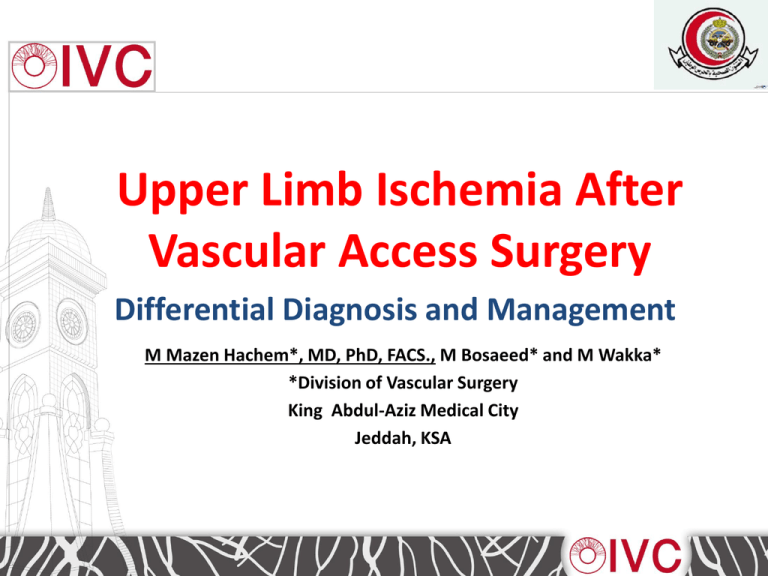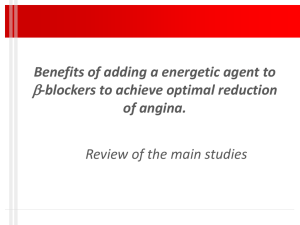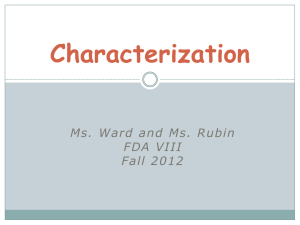
Upper Limb Ischemia After
Vascular Access Surgery
Differential Diagnosis and Management
M Mazen Hachem*, MD, PhD, FACS., M Bosaeed* and M Wakka*
*Division of Vascular Surgery
King Abdul-Aziz Medical City
Jeddah, KSA
Ischemic Complications of VA
• Ischemic Steal Syndrome (ISS) & Ischemic
Monomelic Neuropathy (IMN) are devastating
complications of VA procedure and mostly are
subject to malpractice & lawsuit
• 90% have steal phenomena
– 5-20% have ischemic steal syndrome
– 0.5-1% have IMN
Duncan et al., JVS 4: 144, 1986
Odland et al., Surgery 110:664, 1991
Ischemic Complications of VA
Ischemic Steal Syndrome
• ISS results from uncompensated steal
phenomena Regardless of VA flow
– Poor collaterals
– Proximal arterial stenosis
• Reversible if treated promptly
Ischemic Complications of VA
Ischemic Monomelic Neuropathy
• IMN results from blood flow alteration
to vasa nervosum of Median, Radial &
Ulnar nerves producing claw hand.
Regardless of VA flow.
– Irreversible even with
appropriate strategy and early
intervention.
• Absence of severe tissue ischemia
differentiate IMN from ISS.
Objectives
1. Recognize clinical presentations
– Ischemic Steal Syndrome
– Ischemic Monomelic Neuropathy
2. Be familiar with treatment options
3. Select appropriate treatment options for
each case.
Ischemic Steal Syndrome
Ischemic Monomelic Neuropathy
Predominant feature
Cold hand with pain on
or off dialysis
Weakness and paralysis
of muscles with
prominent sensory loss
Onset
Acute and chronic
Immediately
Access type
Common with upper
arm but also seen with
forearm accesses
Only in proximal access
Sex
Variable
Female>Male
Tissue involved
Skin > muscle > nerve
Nerves
Cause
Vascular insufficiency
leading to distal
hypoperfusion
Vascular insufficiency
causing nerve damage
Radial pulse
Usually diminished or absent
Usually present
Diagnostic evaluation
History,/ physical examination,
and arteriography
History and the clinical
features
More prevalent in
Patients with diabetes,
peripheral vascular
disease, smokers
Patients with diabetes,
peripheral vascular
Disease + PN
Management strategies
Percutaneous and or
Surgery
Access ligation?????
Ischemic Steal Syndrome
Diagnosis
• History/ Physical
examination
– Coldness
– Radial pulse W/O access
occlusion
– Motor weakness &
Sensory deficit
– Trophic changes (late
SS).
Ischemic Steal Syndrome
• Vascular Lab
Diagnosis
– Significant reduction in digital pressure and pulse
volume recording
– Digital pressure and pulse volume improve
• Occlusion of AVF
• Occlusion of V outflow
• Occlusion of RA distal to AVF
– Digital pressure and pulse volume made worse
• Occlusion of RA proximal to AVF
• Occlusion of UA
• Angiogram
Grading of Ischemic Steal Syndrome
Grade
Symptoms
Management
0
I
Asymptomatic
Nothing
II
Ischemic symptoms
during dialysis
“Claudication”
Non-Invasive Study
Medical + Angiogram
PTA/ Surgery
III
Rest pain / Tissue loss
Angiogram & proceed
Cold hand with tolerable Observation
symptoms
Flow augmentation by
access occlusion
Ischemic Steal Syndrome
Goals of Treatment
• Restore perfusion to the hand
• Maintain Vascular Access
Ischemic Steal Syndrome
Treatment Options
• Do nothing
• PTA
• Surgery
1.
2.
3.
4.
5.
6.
Access ligation
Banding
Distal Revascularization-Interval Ligation (DRIL)
Distalizaion of arterial inflow (RUDI)
Proximalization of arterial inflow (RUPI)
Minimally Invasive Limited Ligation EndoluminalAssisted Revision (MILLER)
Treatment Options
Access Ligation
• Restore perfusion
• Lost Vascular Access
Banding
• “Blind” banding w/o
consideration of access flow
is ineffective and ill-advised.
Treatment Options
What’s a DRIL Procedure?
• Bypass increase distal
flow
• Eliminate steal
phenomena due to
arterial ligation
• Resolved ischemia
Procedure
– Distal flow depending bypass
Schanzer H, Schwartz M, Harrington E, Haimov M:
Treatment of ischemia due to “steal” by arteriovenous fistula
with distal artery ligation and revascularization.
J Vasc Surg 7: 770–773, 1988
Brachial artery
Cephalic vein
Anastomosis site
Brachial-to-brachial bypass
Interval ligation
mmhachem 2006-2007
Treatment Options
RUDI
Procedure
• Increase distal flow
• Decrease steal
phenomena
• Distal ischemia resolved
Minion DJ, Moore E, Endean E: Revision using distal inflow:
A novel approach to dialysis-associated steal syndrome.
Ann Vasc Surg 19: 625–628, 2005
Treatment Options
RUPI
Procedure
• Increase distal flow
• Eliminate steal
phenomena due to
high graft resistant
• Resolved ischemia
J Zanow, U Kruger, H Schlz: Proximalization of arterial
inflow: A new technique to treat access-related ischemia;
J Vasc Surg, 43:1216-1221, 2006
Treatment Option
What’s a MILLER
Minimally
Invasive
Limited
Ligation
Endoluminal assisted
Revision
Gregg A. Miller, MD. 2006
Outpatient Procedure
MILLER Procedure
Treatment Options Guideline
ACCESS FLOW MEASURMENT
Treatment Options Guideline
Measurement Access Blood Flow
• Access blood flow will
dictate management
option:
– Low or normal access
flow
• DRIL
– High access flow
• MILLER or RUDI or
RUPI
RESULTS
Authors
Year
Proc.
No. Pt.
Results
De Caprio
1997
Banding
18
100% ischemia resolved
1/11 AVG patent at 6 m
0/7 AVF patent at 30 D
Haimovici
1996
DRIL
34
100% ischemia resolved
73% AVG patency at 1 year
96% bypass patency at 1 year
Hachem
2006
DRIL
16
90% ischemia resolved
87.5% VA patency at1 year
81% bypass patency at 1year
Zanow
2006
RUPI
30
80% ischemia resolved
90% patency
MILLER
2010
MILLER
114
96% ischemia resolved
90% patency at 1 year
Minion
2005
RUDI
6
100% ischemia resolved
100% patency 14m
Minion
2005
RUPI
4
100% ischemia resolved
100% patency at 1 year
Conclusion
• Pay special attention to the elderly diabetic
females with neuropathy
– Immediate evaluation if post-op hand pain or
other evidence of significant ischemia
• Diagnosis almost can be made on clinical
features & non-invasive studies
• Angiogram is mandatory
• Proximal arterial stenosis is a common contributing
factor to hand ischemia
Conclusion
• Surgical treatment should provide
– Adequate access flow
– Restoring adequate flow to the extremity.
• Main treatment options for ischemic steal
syndrome
– MILLER procedure
– RUDI
– RUPI
– DRIL
• Challenge is there for IMN







